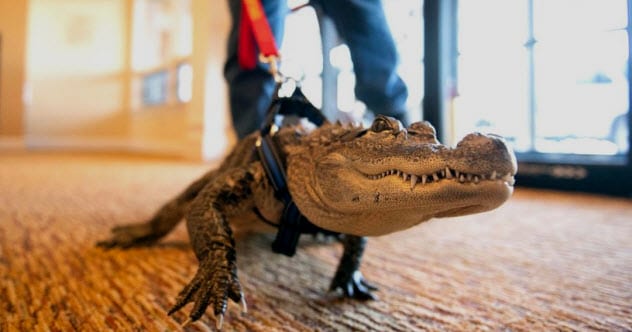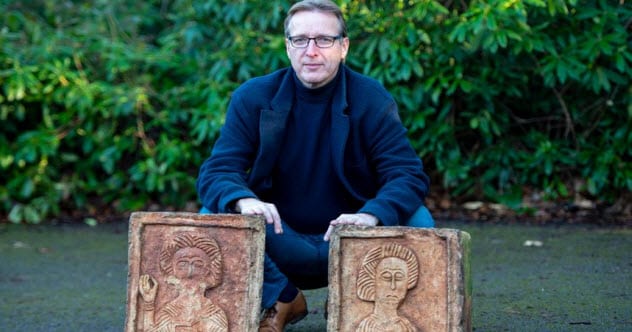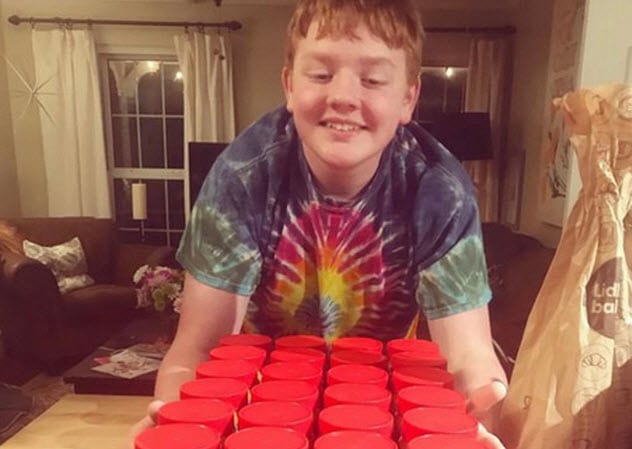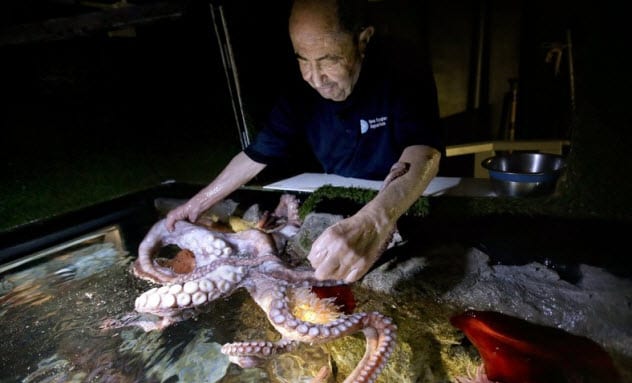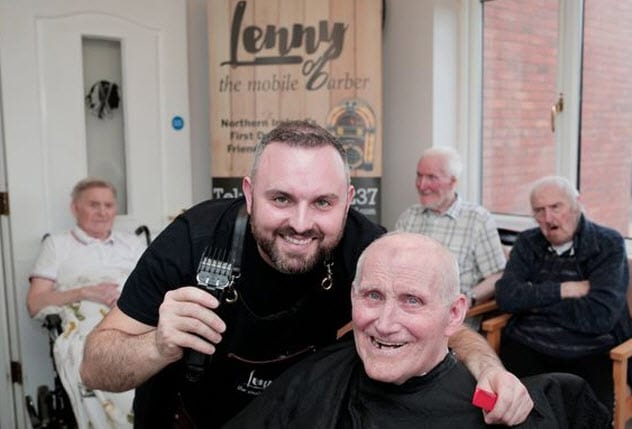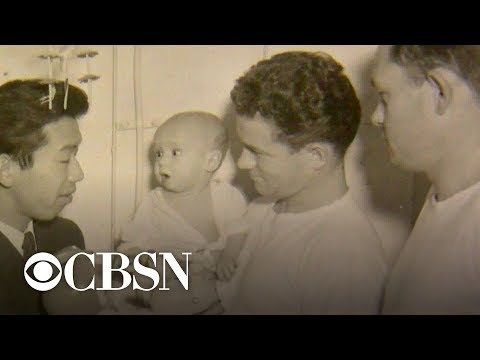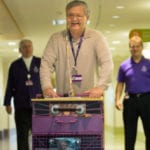This week is full of stories of people doing nice things for strangers. There’s a man who gave a ride to a doctor carrying a transplant organ, a kid who shared his peanut butter, and a barber who specialized in customers with dementia. There is also a touching reunion, a man who is an “octopus whisperer,” and a gator that acts as an emotional support animal.
10 See You Later, Wally Gator
A recent visit from Joie Henney to the Glatfelter Community Center in York, Pennsylvania, went viral because he brought along his faithful companion, an emotional support animal named Wally. There’s one catch: Wally is a 1.4-meter-long (4.5 ft) alligator. Henney rescued Wally about three years ago when he was just a pup. Since then, his upbringing has been more like a dog than a reptile. At first, Wally was scared of everything and everyone, but he slowly became more domesticated. He likes to follow people around the house, root through the kitchen cupboards, and watch TV. According to Henney, Wally’s favorite movie is The Lion King. He always watches it through to the end and even refuses to eat while the film is on.[1] Wally helped Henney deal with his depression, so he thought that the “big teddy bear” would make for a good support companion. Henney brings the gator to schools and senior centers where both young and old have lots of questions and take a lot of pictures.
9 Write A Letter, Win A House
A woman from Canada is awarding her million-dollar home to the winner of a writing contest. Alla Wagner has a beautiful mansion about 65 kilometers (40 mi) south of Calgary, Alberta. She describes it as a “writer’s or artist’s paradise” with breathtaking, panoramic views of the Rockies. However, her poor health has left her confined to the upper floor. Unable to enjoy the house to its fullest, Wagner decided to sell it. She put it up for C$1.7 million, but there were no buyers. Instead, she decided to award it to a contest winner.[2] The competition will go on for at least three months. All participants must write an essay on the topic “Why would moving to this lakefront dream home change your life?” and submit it with a C$25 entry fee. Five hundred finalists will be selected through public voting, and an independent panel of judges will select a winner. Wagner says she was inspired by similar contests held in recent years, but these raffles don’t always go smoothly. Some were under investigation to determine if they were illegal or rigged, while others were canceled due to lack of entries. This competition may also be extended or even canceled if it doesn’t gain 60,000 entries to cover the house’s minimum listing amount.
8 Indiana Jones And The Garden Decorations
Just a few months ago, we talked about Arthur Brand, the Dutch art detective billed as the “Indiana Jones of the art world.” Back then, he recovered a sixth-century Byzantine mosaic. Brand is again in the news after finding a pair of seventh-century Visigoth reliefs which have been sitting in someone’s garden for 15 years. In 2004, the carvings were stolen from the Santa Maria de Lara church near Burgos in northern Spain. The structure is one of the last-surviving Visigoth churches on the Iberian Peninsula, and the reliefs were at least 1,000 years old. They ended up in the hands of a French dealer who sold them as garden ornaments worth £50,000 each to an English noble family living in North London. After nine years of searching, Brand received a tip from an informant about the artworks. He confronted the unidentified owners, who were shocked to find out the true origins of their garden decorations.[3] The nobleman willingly handed the reliefs to Brand. In turn, he gave them back to Spanish officials at their London embassy during a private ceremony on Monday.
7 Transplant Taxi
Somewhere in Pennsylvania, there is a person who received a second chance at life because Brad Dostlik likes to listen to his police radio and felt like doing a good deed. Watch this video on YouTube Dostlik heard an unusual call over the radio—a doctor’s car had broken down while carrying sensitive cargo. That cargo was an organ which was due to be transplanted in just a few hours into 63-year-old Tom Loree at the UPMC Hamot Medical Center in Erie. Knowing that he was close, Dostlik jumped in his car and went to find the stranded surgeon.[4] Dr. Martin Wijkstrom was grateful for the assistance as a hospital response team was a long distance away and probably would not have arrived on time. Fortunately, Dostlik had a full tank of gas and was willing to drive the doctor 177 kilometers (110 mi) to reach Loree, who was suffering from kidney failure. At 1:45 AM, Dostlik received a text that Loree was out of surgery and the transplant had been a success.
6 New Diagnostic Test For Alzheimer’s
Researchers from the German Center for Neurodegenerative Diseases in Tubingen have developed a blood test which could detect the presence of Alzheimer’s disease over a decade before symptoms start to appear. The test examines the levels of a protein called neurofilament light chain (NfL) in the blood and spinal fluid. Previous studies suggested a link between increased levels of NfL and brain damage and that the protein could be used as a marker for the progression of neurological conditions such as Alzheimer’s. In a study with over 400 test subjects, the German team found that differences between people genetically predisposed to Alzheimer’s and those without a mutation of interest become apparent 16 years before the onset of symptoms. Study coauthor Professor Mathias Jucker believes that the test will be useful not only in treating patients as early as possible but also in helping to determine the efficacy of future drugs to treat Alzheimer’s. Dr. James Pickett, head of research at the Alzheimer’s Society, described the new development as helpful but also pointed out that it had limitations. It only looked at people with a genetic predisposition for the disease and didn’t account for the fact that other health problems such as multiple sclerosis could also increase NfL levels.[5]
5 Peanut Butter Giveaway
A 15-year-old autistic boy from Virginia is sharing his lifetime supply of peanut butter with government workers affected by the shutdown. The United States federal government shut down on December 22, 2018, with hundreds of thousands of people required to work without pay while others have been furloughed. Since then, many organizations and private citizens have offered assistance in various ways. (The shutdown officially ended on January 25, 2019.) One notable helper is Eric McKay from Woodbridge, Virginia. Also known as “Bean,” McKay absolutely loves peanut butter and eats it every day. Therefore, when Lidl had a sale, his mom, Tracy, stocked up on 72 jars. Inevitably, Bean went through the entire supply. He numbered each jar, took a picture with them, and tweeted it at Lidl. The company was so impressed with Eric’s love for its product that it not only sent him another 72 jars but also promised him a lifetime supply of peanut butter if he garnered 72,000 retweets.[6] Last week, Eric reached his goal, partly thanks to author Neil Gaiman who shared the original tweet with his 2.5 million followers. Eric also announced plans to share his winnings with federal workers affected by the shutdown. (That included his father.) They can claim up to three jars of peanut butter from Eric’s “stash” for free by showing their government ID at the Lidl in Dumfries, Virginia.
4 The Octopus Whisperer
An 84-year-old man has spent over 7,800 hours volunteering at the New England Aquarium in Boston and has become known as the “octopus whisperer.” Twenty-five years ago, Wilson Menashi retired from his career as a chemical engineer. To pass the days, he began visiting the aquarium and started spending time with the cephalopods. He quickly realized that he had a knack for it.[7] Even decades later, Menashi admits that he can’t quite explain how he connects so strongly with the octopuses. Senior aquarist Bill Murphy believes that Menashi’s secret involves understanding that each octopus is different and using patience and experimentation to get on its good side. At the moment, Menashi enjoys interacting with two cephalopods—a three-year-old female named Freya and a younger male called Professor Ludwig Von Drake. The octopus whisperer might go home with suction cup hickeys every day but never with serious injuries. Menashi describes the time spent with the octopuses as “a lifesaver” which gave him purpose after retirement.
3 Barber Services For Dementia Patients
Lenny White has developed a reputation as a dementia-friendly barber who offers his customers the traditional hot towel shave-and-a-haircut and “a bit of dignity.” White’s career started recently following his divorce. He remembered fondly the time he spent when he was 17 working in a care facility and the knack he had for interacting with dementia patients. He took a barbering course and volunteered at a senior facility in his hometown of Bangor, Northern Ireland. Lenny created the right atmosphere, complete with traditional barber pole and apron, lemon-scented cologne, and Dean Martin and Elvis Presley playing in the background.[8] The staff noticed a huge difference in their patients as even the most agitated men became more easygoing and relaxed. Word of Lenny’s services spread, and now he travels all over the United Kingdom to snip the hair of men with dementia. He even journeyed to New Jersey. Lenny has added a portable jukebox and a robotic dog to his arsenal and is constantly improving at the “man-banter” he has with his customers. Men come in groups to recreate the camaraderie they felt in their younger days while in line at the barbershop. Research suggests that what Lenny does is not only uplifting but also therapeutic for people with dementia as they respond well to stimuli which hark back to their younger days.
2 The Medic Meets Baby George
A former Navy medic reunited with the baby he helped to save over six decades ago during the Korean War. Norm Van Sloun was born in Chaska, Minnesota, and enlisted when he was 21. In 1953, he served aboard the USS Point Cruz as one of only two hospital corpsmen caring for 1,000 soldiers. They became 1,001 after sailors walking through Seoul found a baby dumped in an ash can. He was half-Korean and half-Caucasian with blue eyes and blond hair, so the orphanages turned him away. The baby was brought aboard ship and placed in the care of the two medics. They named him George Ascom Cruz. A Japanese newspaper first told the story of Baby George which eventually spread to the United States. An iconic photo of Van Sloun feeding the infant made the front pages across the world and was used for morale-boosting promotional material. Norm cared for George for three months but never knew exactly what had happened to him until recently. His daughters took to social media in an effort to find George, and 66 years later, the two saw each other again. Vice President Richard Nixon got a visa for Baby George. He was adopted by a Navy surgeon in Spokane, Washington, and became Dan Keenen.[9]
1 Life Beneath The Ice
For the first time, scientists have explored Lake Mercer, a subglacial body of water in Antarctica covered by a sheet of ice over 1,100 meters (3,500 ft) thick. They thought they might find microbes, but they actually discovered ancient carcasses of tiny animals such as crustaceans and tardigrades. Mercer is part of a network of hundreds of underground lakes buried beneath the Antarctic ice. It has been undisturbed for thousands of years, even hundreds of thousands of years, depending on when the last warm period occurred where the glaciers receded. An expedition called Subglacial Antarctic Lakes Scientific Access (SALSA) has brought together researchers from over a dozen universities to study these untouched environments. Lake Whillans was the first in 2013, and now Mercer is the second.[10] To their surprise, scientists found Whillans to be teeming with microbes far more than they expected from a place so isolated from the Sun’s energy. Even so, the findings in Lake Mercer were so staggering that project leader John Priscu had the equipment cleaned and used again because he thought it had been contaminated. Researchers recovered shells and other bits from crustaceans, one tardigrade, and pieces of fungi. Some of them still had little hairs on them. These are in addition to the countless microbes that live in the lake. While unlikely, SALSA scientists are not completely ruling out the possibility that small animals could still be alive in the lake, feeding off bacteria. Priscu believes that this would be a “real wow moment.” There is a lot more information to be gleaned from Lake Mercer in the weeks and months to come. Scientists also look at it as an analogous habitat for subglacial biospheres on other worlds such as Mars or Europa. They believe it could provide insight into what kind of life could survive in such conditions.
